Native plants and Hill Country style at Paula Stone’s Fredericksburg garden
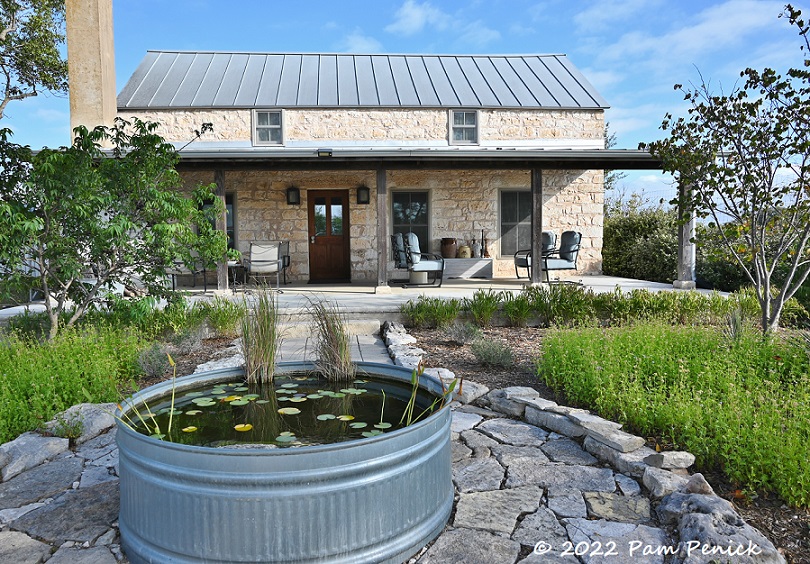
Two Fridays ago a couple of friends and I drove out to Fredericksburg, a charming town in the Texas Hill Country, founded in the mid-1800s by German immigrants and built out of native limestone block, pressed-tin ceilings, and galvanized roofs. We’d been invited to visit by Paula Stone, president of the Fredericksburg chapter of the Native Plant Society of Texas and owner of a wedding venue called Gilbriar Gazebo surrounded by native-plant gardens.
Paula is a straight talker with a passion for native plants, a knack for turning her creative design ideas into reality, and a lifelong dream of living in a modern, eco-friendly dome house. That’s her next house. For now she lives in her 140-year-old stone house on 10 acres. The picturesque, German-built farmhouse was a wreck when she bought it in 2009, its interior so derelict that her realtor wouldn’t even step inside while Paula poked around, gauging its potential amid abandoned dog cages and other debris.
Twenty years as an interior designer in San Antonio, and as an Arabian horse breeder as well, taught Paula to recognize potential when she sees it. She was sure she saw it here. She began by paring away a clumsy addition and opening the house to the outdoors with an extra-deep front porch overlooking a flagstone walk that flows around a stock-tank pond. Blue mistflower and inland sea oats, along with Mexican buckeye and Texas redbud, natives all, fill out the front yard where others might have sodded a lawn.
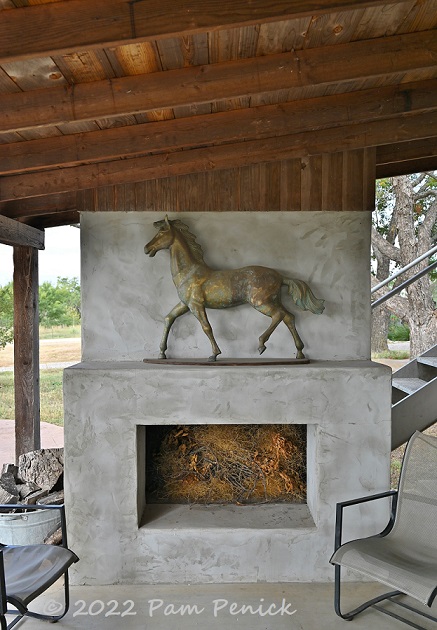
One end of the porch is anchored by an outdoor fireplace — formerly an interior fireplace before Paula ripped out a poorly constructed add-on, pruning the house back to its creamy limestone frame. The preserved fireplace spat flames until she had the idea of deepening its surround, giving it a chunky, modern look in the process. That did the trick, and it gave her a place to display one of many horse figures adorning the property, a nod to her years as a horse breeder.
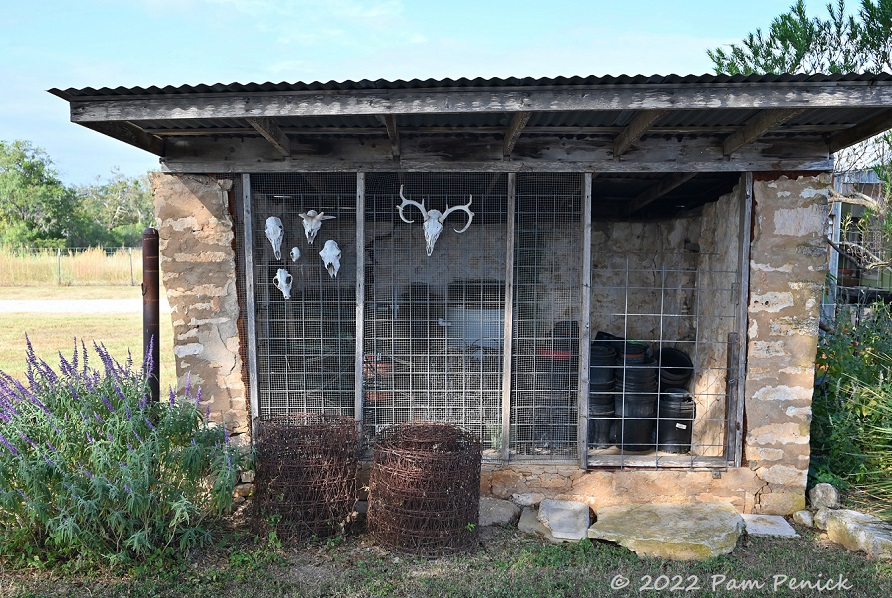
A number of outbuildings provide storage, like this stone-framed shed decorated with animal skulls.
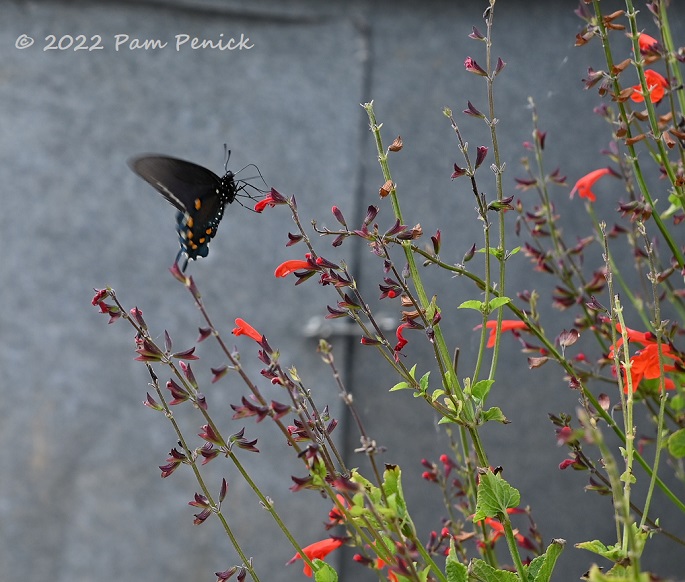
Swallowtail butterflies were swarming through the gardens, drawn largely to scarlet sage (Salvia coccinea) in fiery red bloom.
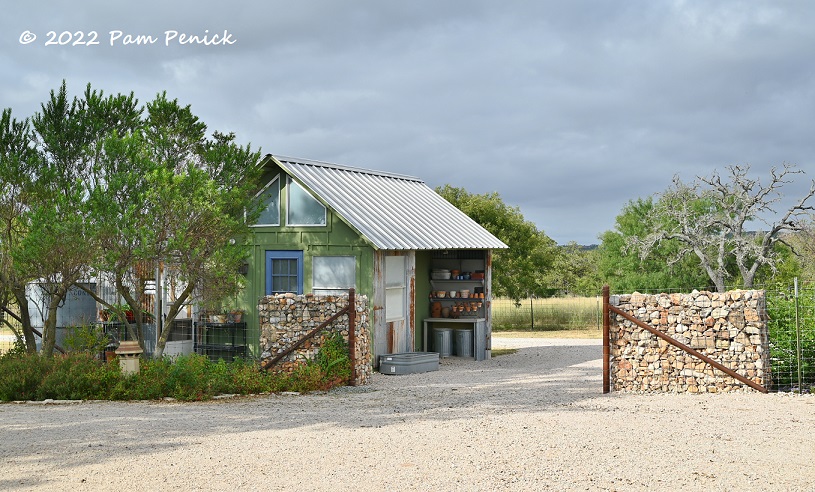
A green-and-blue garden shed and attached greenhouse are set off by a desert willow and gabion walls made with chunks of limestone unearthed on-site.
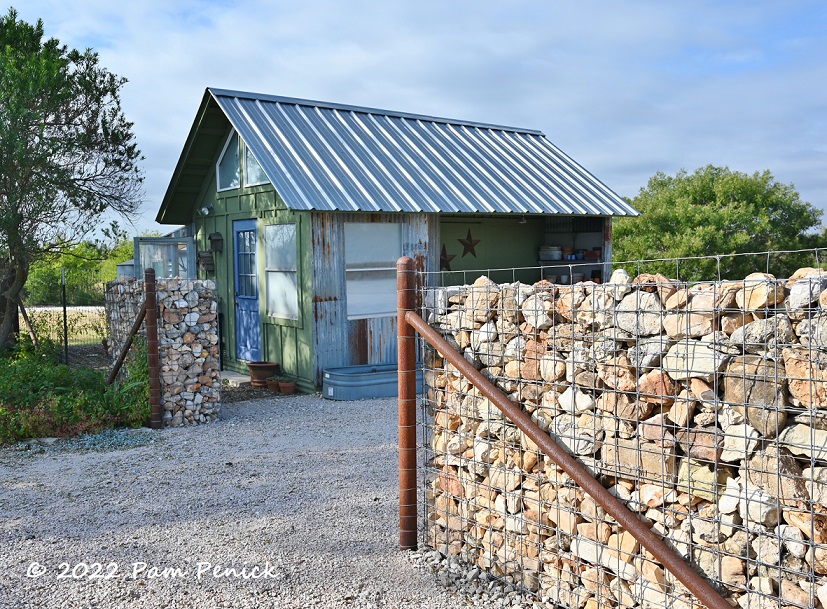
I was smitten by the gabion walls, which mark the entrance to the rear garden.
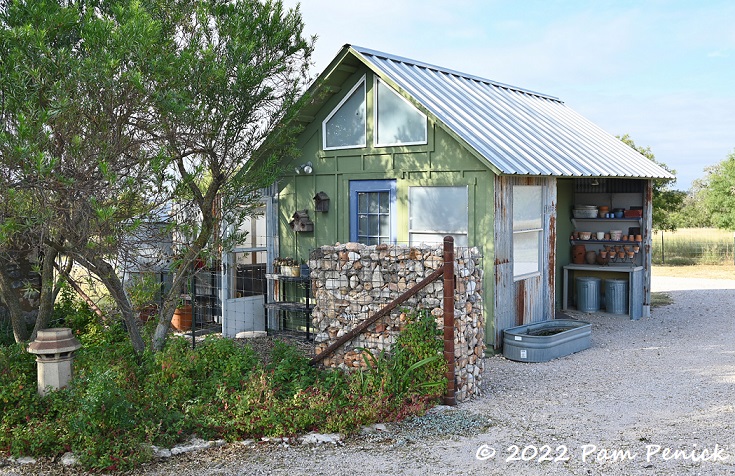
Pigeonberry (Rivina humilis) and autumn sage (Salvia greggii) thrive below the desert willow.
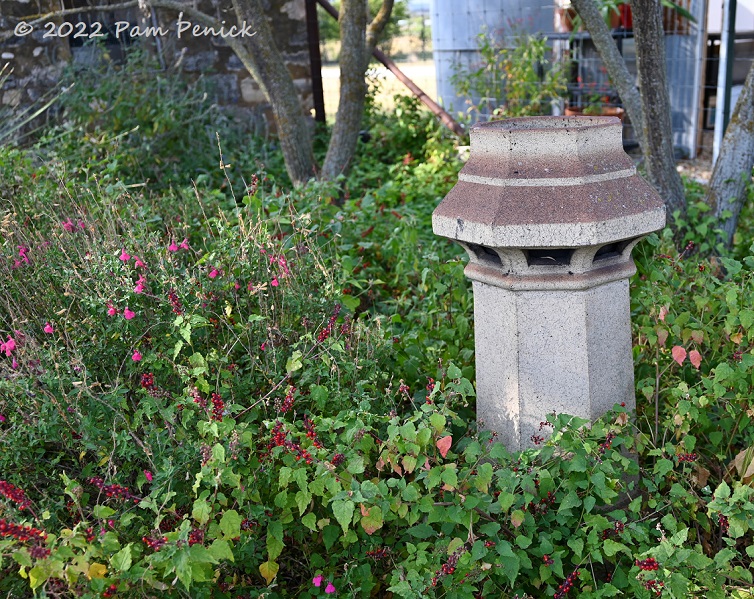
Autumn sage and pigeonberry make a rosy combo.
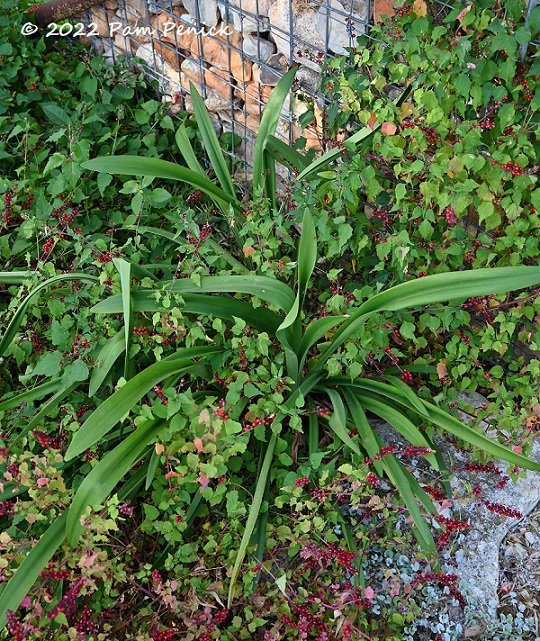
Pigeonberry grows throughout the gardens at Gilbriar. It’s a charming native spreader with red berries and leaves that turn red as well.
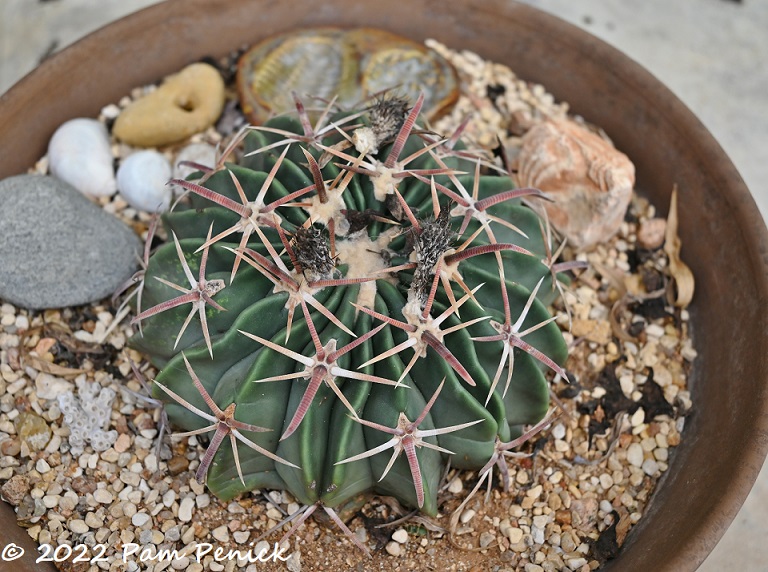
Horse crippler (Echinocactus texensis) and lithops in the greenhouse
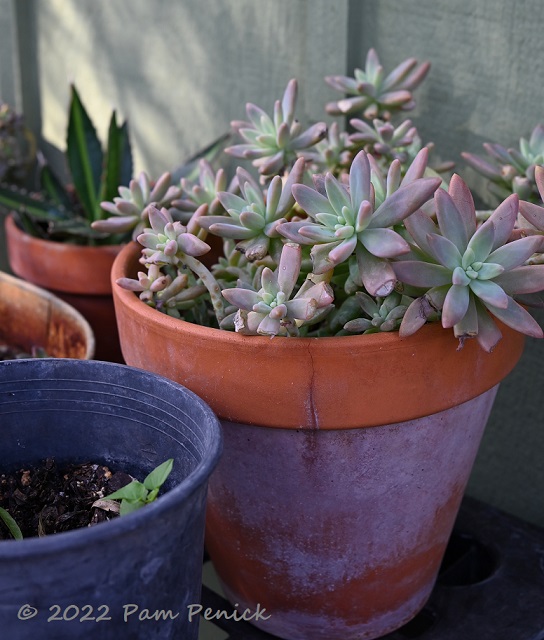
Ghost plant (Graptopetalum paraguayense), its pastel leaves color-coordinating with its pot
Gilbriar Gazebo garden
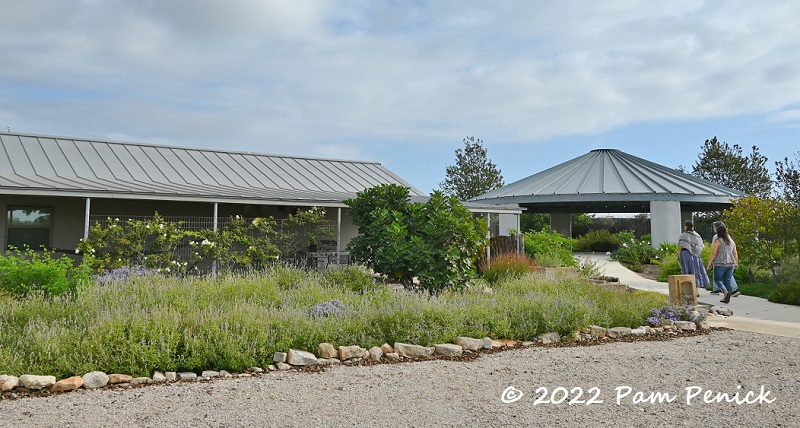
Paula originally planned to run a bed-and-breakfast or long-term rental out of her house but soon realized that wasn’t for her. Instead she turned her attention to a large turkey barn in the backyard. She cleaned it out and put her design eye to work, transforming it into a wedding venue — a smart idea for a picturesque destination town like Fredericksburg. She added a 40-foot-diameter, silo-roofed gazebo that allows for outdoor festivities no matter the weather.
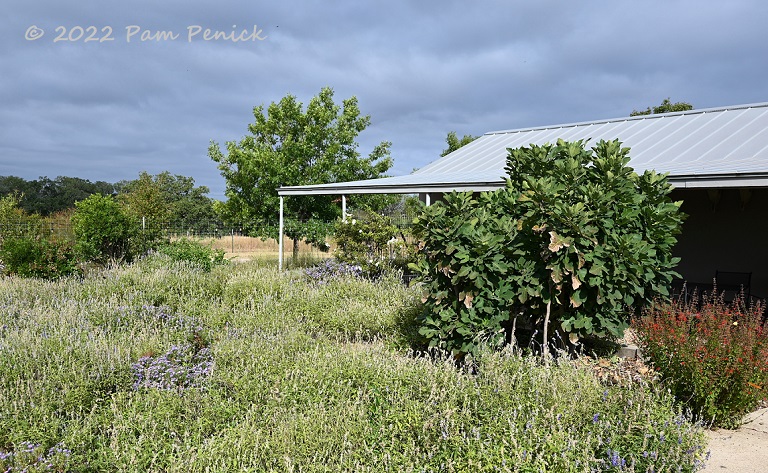
A fig tree in a meadow garden of blue mealy sage (Salvia farinacea) and fall aster (Symphyotrichum oblongifolium)
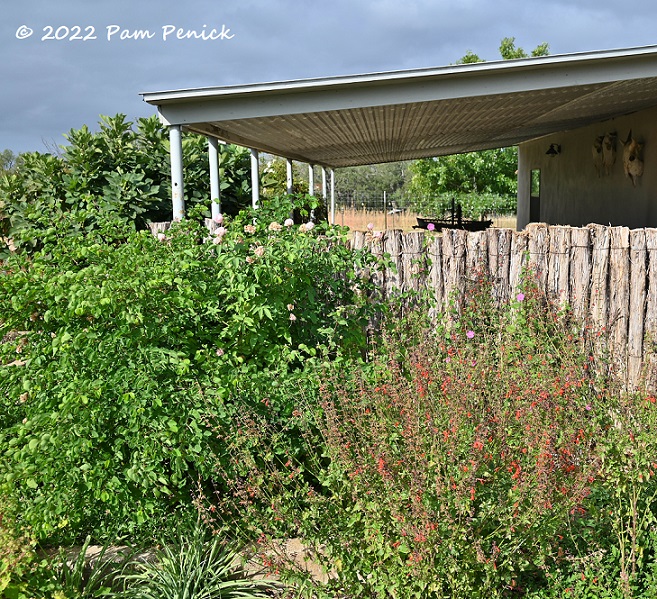
A pink rose, scarlet sage, and rock rose (Pavonia lasiopetala) add color and draw pollinators.
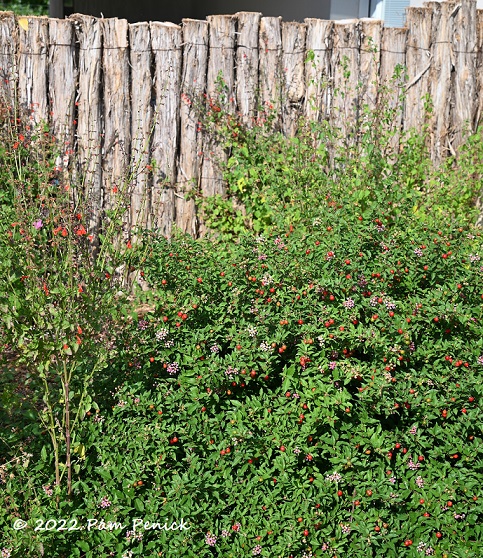
Dwarf Barbados cherry (Malpighia glabra ‘Nana’) adds more pink and red with its flowers and fruit. I like how these appear on the plant at the same time.
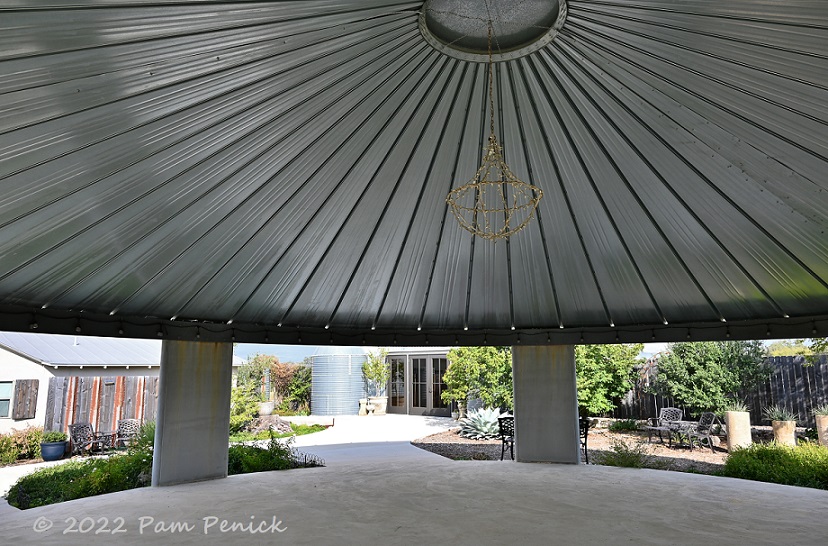
The gazebo’s galvanized roof and chandelier hover over an underground 38,500-gallon water catchment system. It’s easy to imagine brides and grooms spinning across the dance floor atop Paula’s secret stash of pure rainwater for home and garden.
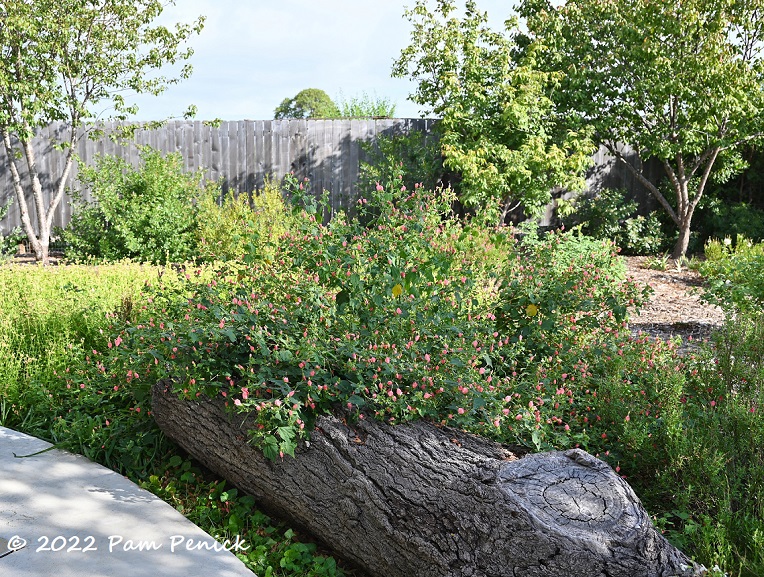
‘Pam’s Pink’ Turk’s cap (Malvaviscus drummondii ‘Pam Puryear’) was in full bloom in the gazebo garden. Paula likes to leave snags (dead trees) standing for wildlife, but when they finally come down she repurposes them in the garden. An impromptu bench perhaps? Plus it’s still benefitting wildlife as it decomposes into soil.
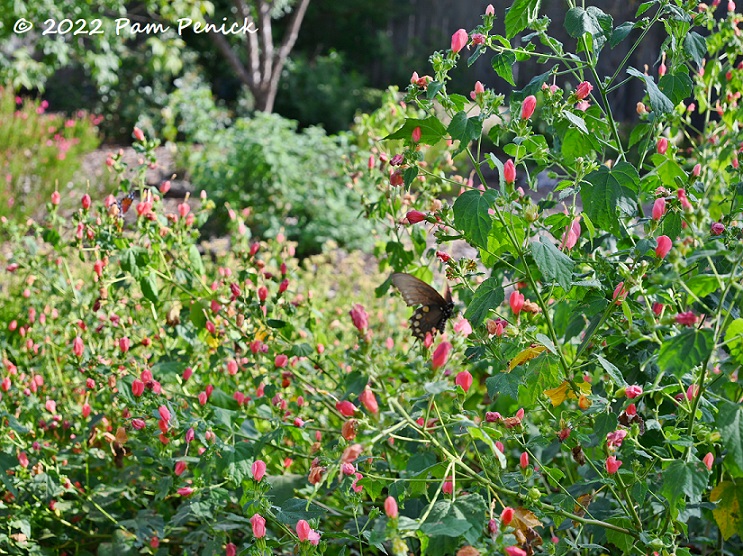
A nectaring swallowtail butterfly on the Turk’s cap
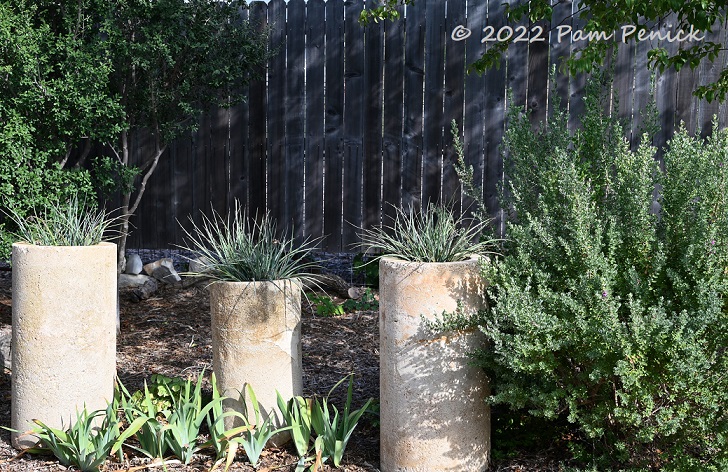
A trio of hesperaloes — dwarf ‘Brakelights’ maybe? — in concrete pipe planters
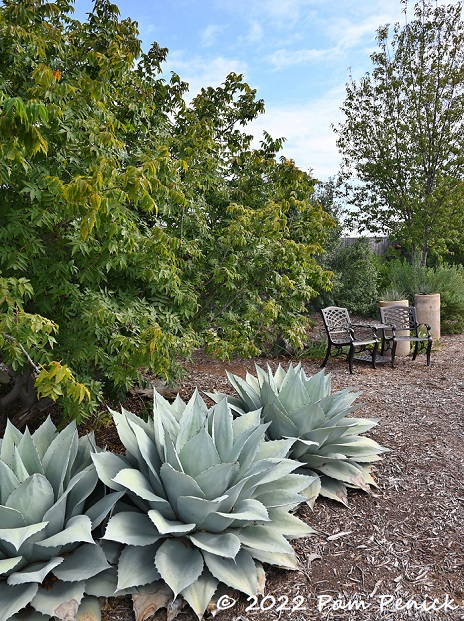
Nearby, three whale’s tongue agaves (Agave ovatifolia) cluster like hammered-steel roses.
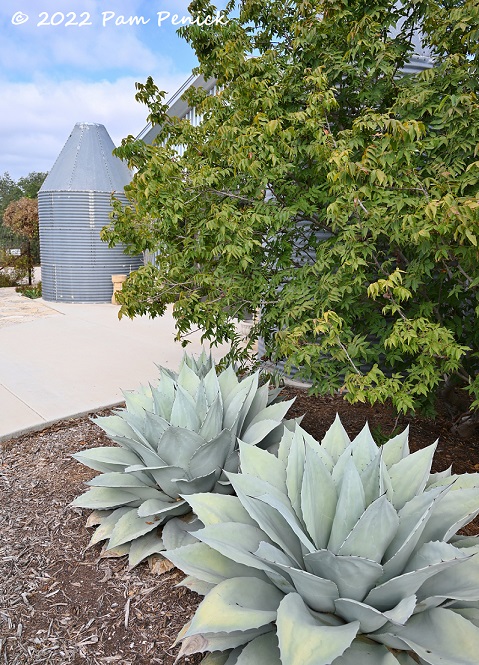
Mexican buckeye (Ungnadia speciosa) grows behind them. Ahead, flanking the doors into the event barn, stand two upside-down bulk feed bins. They add farmhouse style, and on the inside Paula cleverly turned them into intimate seating nooks.
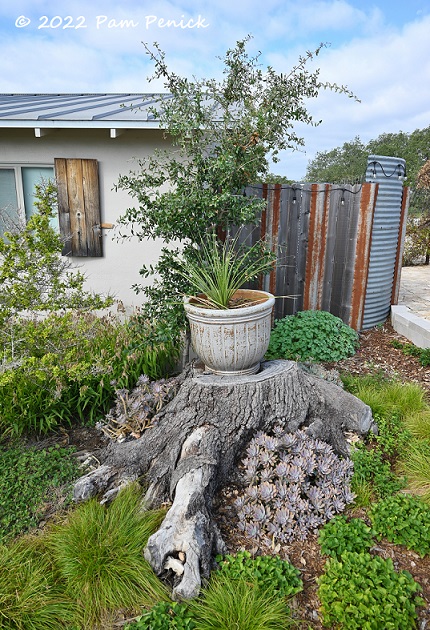
The stump of an old live oak supports a low-maintenance potted Texas sotol (Dasylirion texanum). Around the tree’s gnarled roots grow sedge, ghost plant, columbine, and other small clumping plants. A sapling live oak has sprung up from the back of the stump, and Paula hasn’t had the heart to cut it down. It’s growing too close to the house, she says, but it has such a will to live. For now it’s spared.
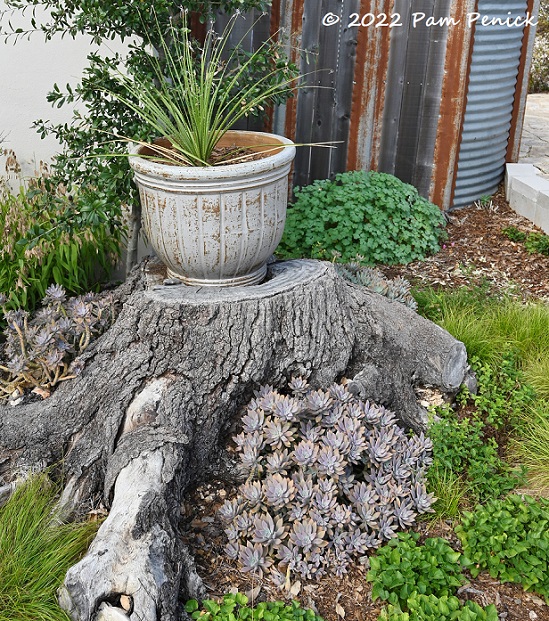
The groundcovers snuggle next to the old stump.
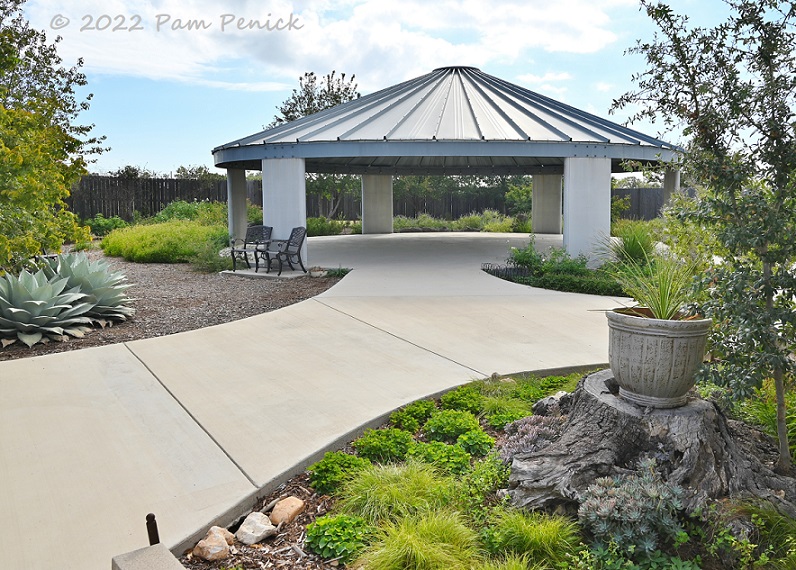
Looking back at the gazebo garden
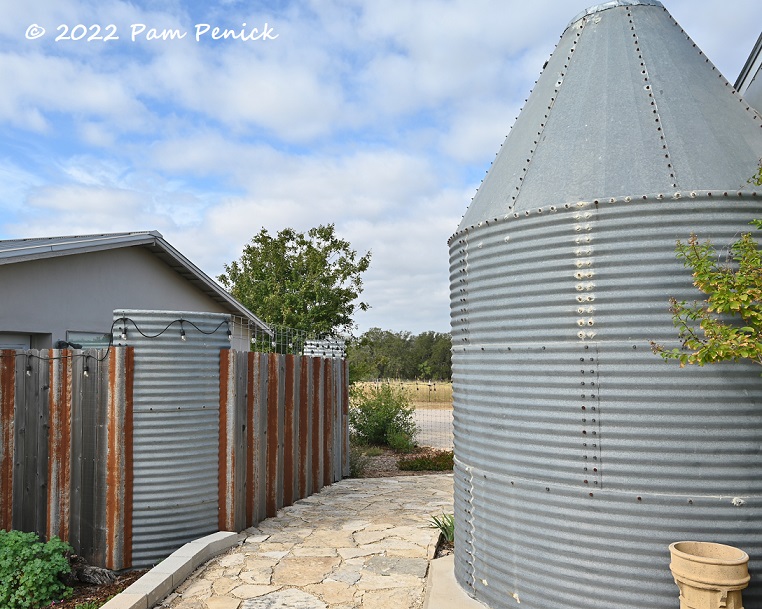
Before we go inside the event barn, let’s explore this side path, past the upside-down feed bins.
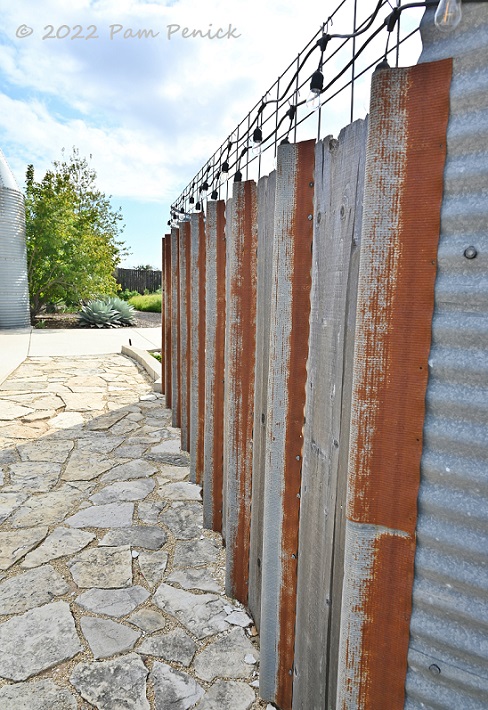
I admired the rusty, curved strips of metal flashing that Paula attached to a wooden fence, creating a patterned, wavy effect.
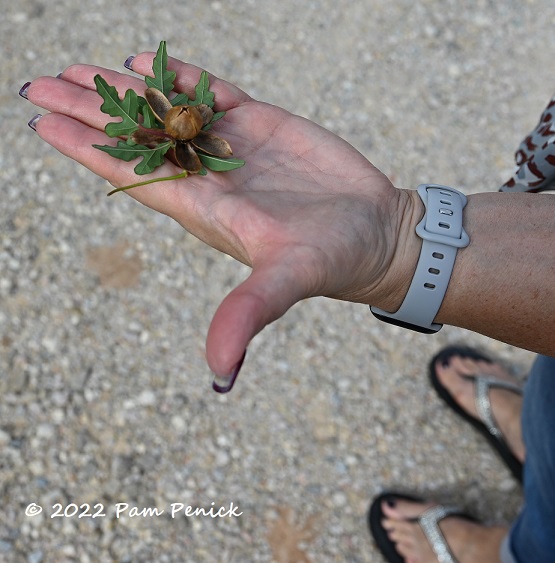
Paula offered us seedpods of alamo vine (Merremia dissecta), which look like something designed to be hot-glued to a wreath or candle.
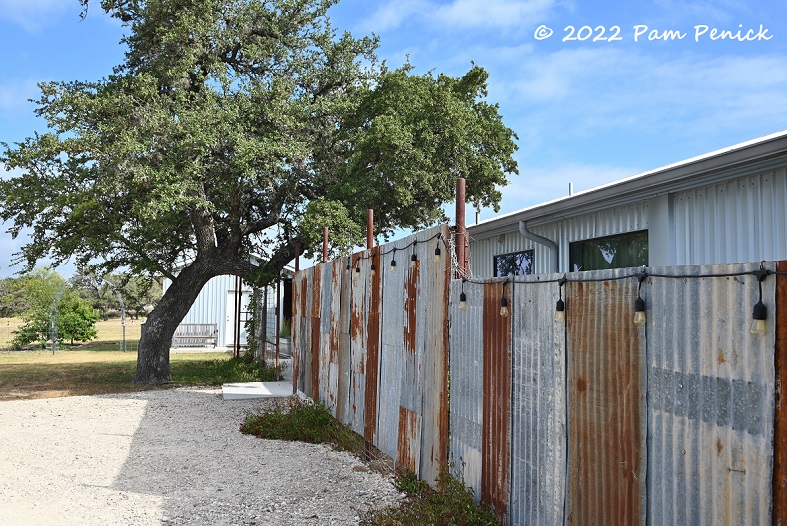
A wonderfully rustic corrugated fence strung with lights runs along the parking area. A live oak arches over one end.
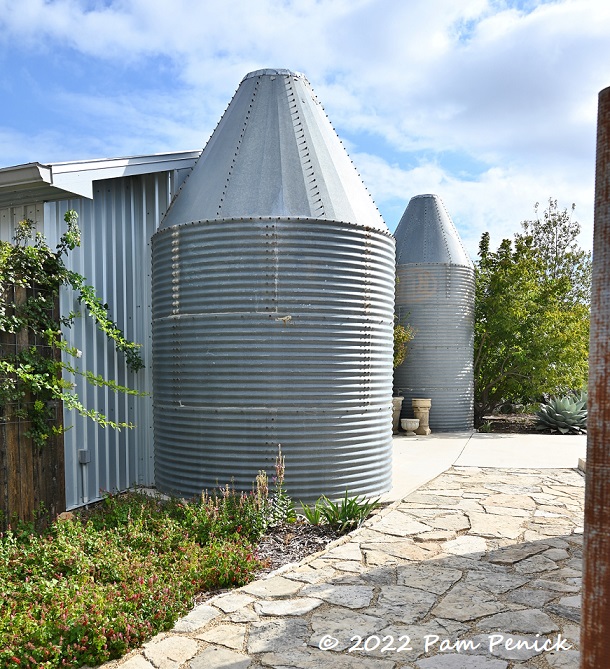
And now let’s head into the event barn.
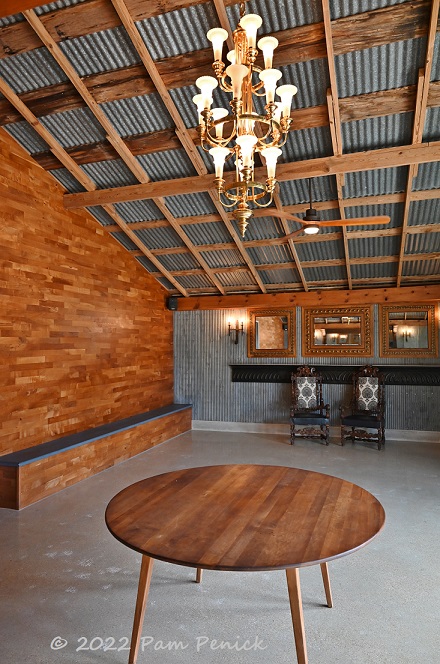
Inside it’s rustic elegance, with corrugated tin walls and roof, a concrete floor, warm wood accents, and glowing chandeliers.
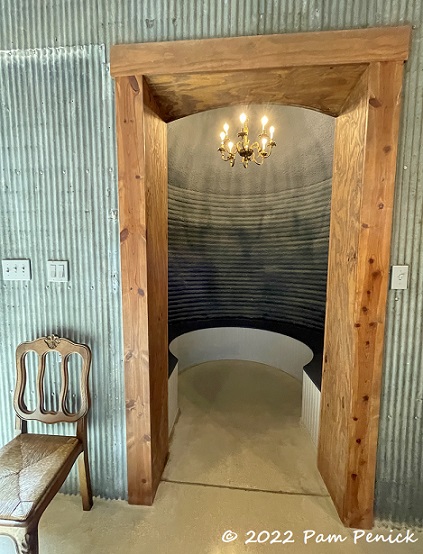
A wood-framed doorway into the feed bin reveals a curved bench and chandelier — a conversation nook! There’s one on each side of the room.
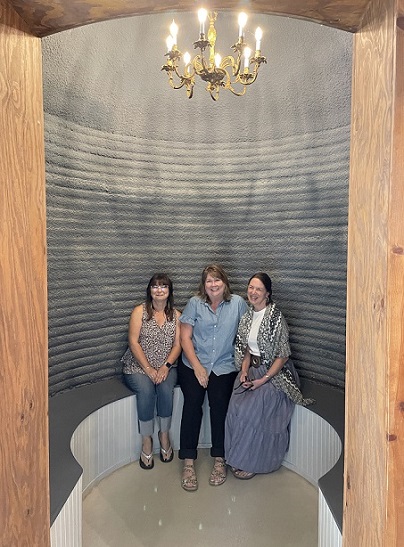
We couldn’t resist it for a photo op.
Back acres
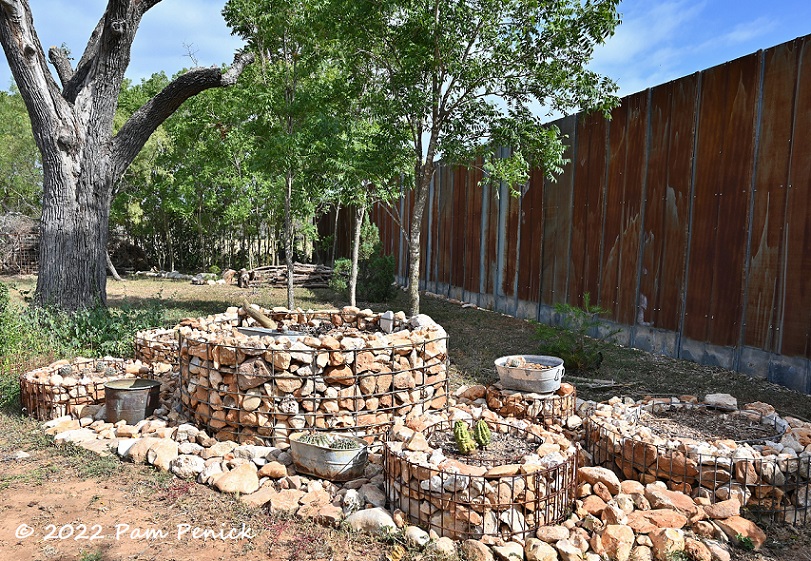
After showing us the rest of the event barn, complete with main hall and dressing rooms for the bridal party and groomsmen, we headed out back, through an orchard and naturalistic gardens. A tall metal fence screens the highway and keeps out deer. Near the back of the property we came across these interesting round gabion planters, which give a growing collection of cacti the sharp drainage they need.
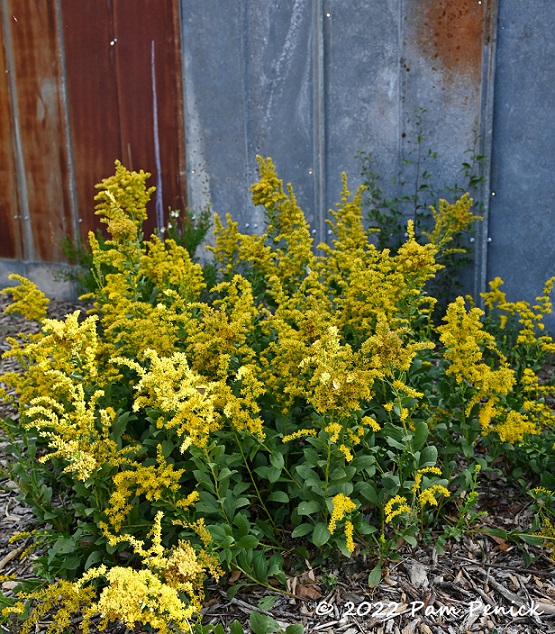
Goldenrod
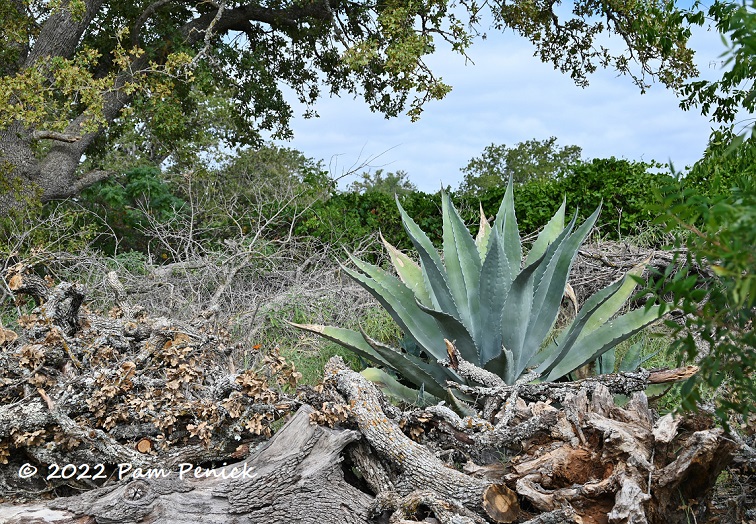
In the very back, Paula has piled broken tree limbs and branches to decompose naturally, with the occasional gigantic agave growing among them. The pile is creating a large berm that gives privacy from a neighboring house.
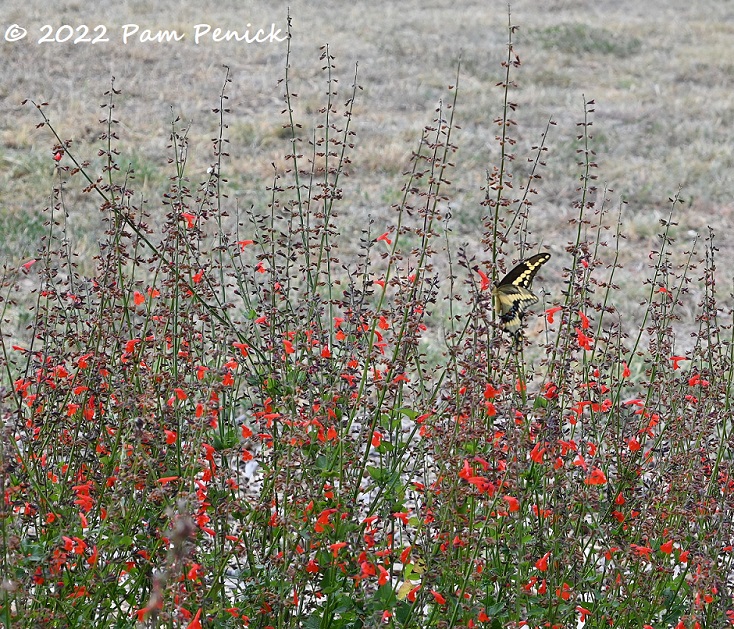
More scarlet sage and one of dozens of swallowtail butterflies we saw nectaring on them
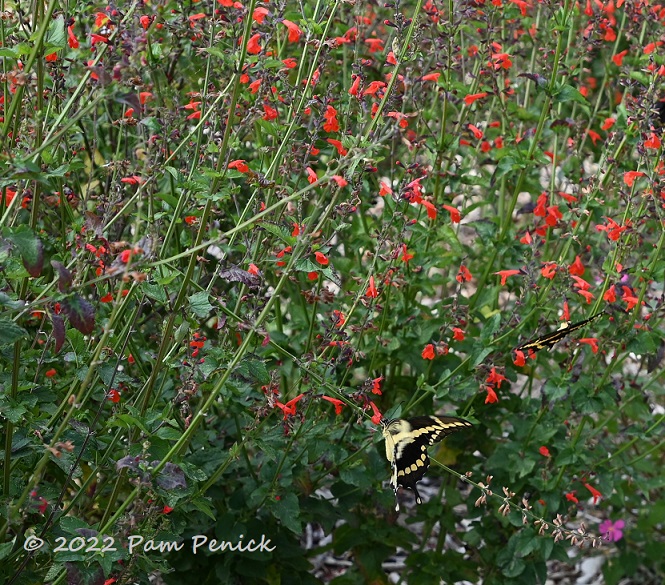
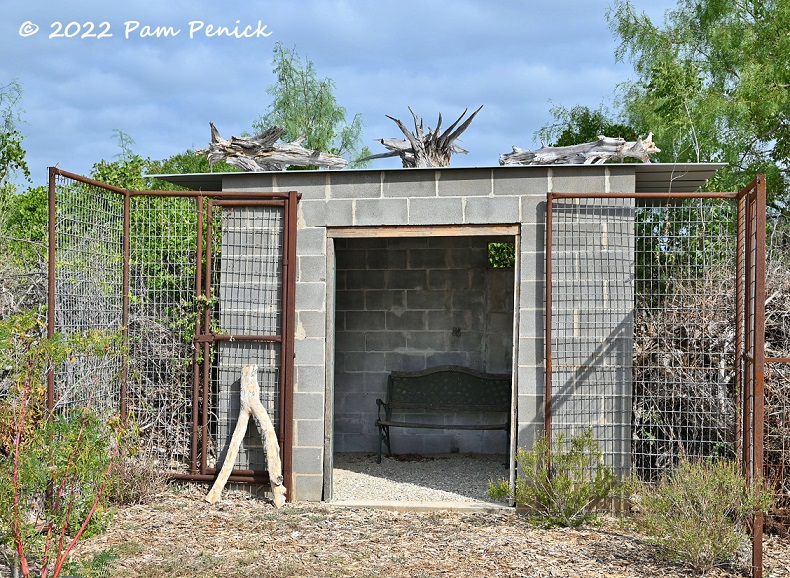
“What are those — sheds?” we asked Paula about 3 or 4 cement-block structures along the property line. “Nope. Lion’s dens,” she replied. I laughed, then realized she was serious. What the what??
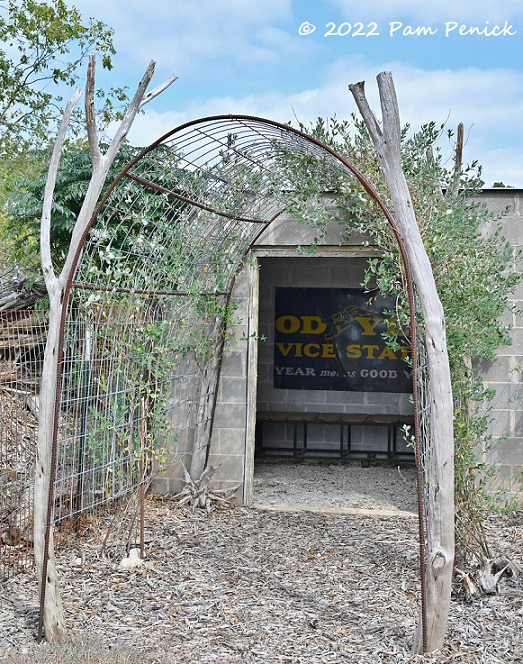
Former owners, she told us, kept caged lions back here. Yikes! I hate to imagine that for many reasons. I poked inside a couple of them, half expecting a ghostly roar of lions past. Paula has turned them into fanciful summerhouses or hideouts, with benches facing an open field. The doorway of one is framed by a wire tunnel arch and juniper branches.
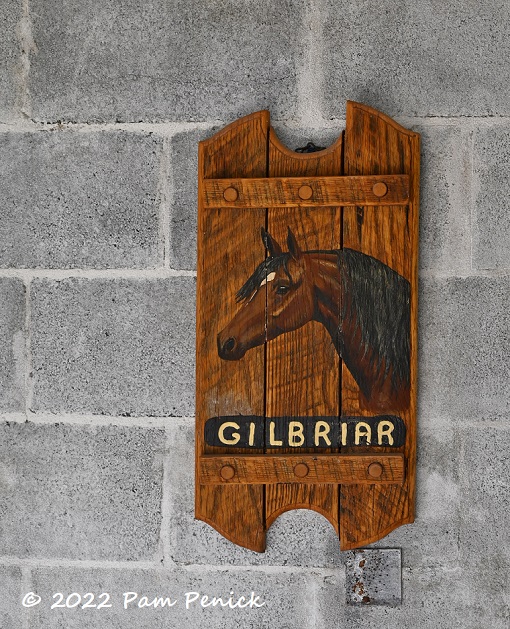
A wooden plaque bears the name of her old horse-breeding business, reused now for her wedding-venue business.
Edible garden

Heading back to the house we stopped to see Paula’s large vegetable garden. It’s appealingly tucked behind a coyote fence lined with galvanized planters. I wish I’d taken photos of the raised beds of metal and stone lining the space inside (you can see a few of them in Shirley Fox’s post from 2018), but I got distracted…
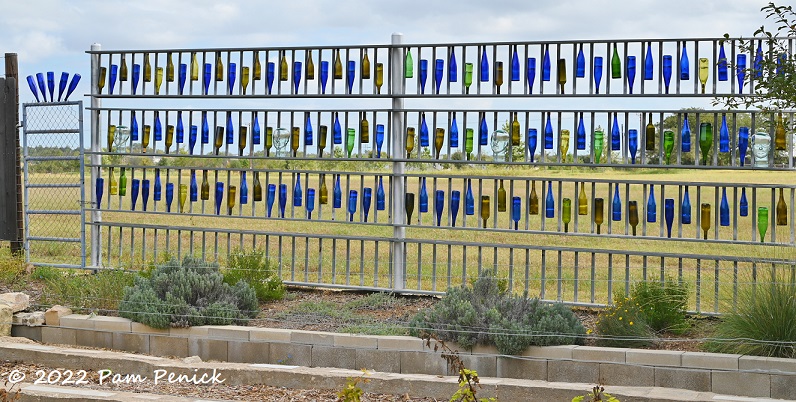
…by a tall fence made of wine bottles! Mostly blue but with green and brown glass mixed in, the bottle fence seems to celebrate, well, celebrations. Paula repurposed steel conveyor frames to construct the screen. I neglected to ask how the bottles are attached.
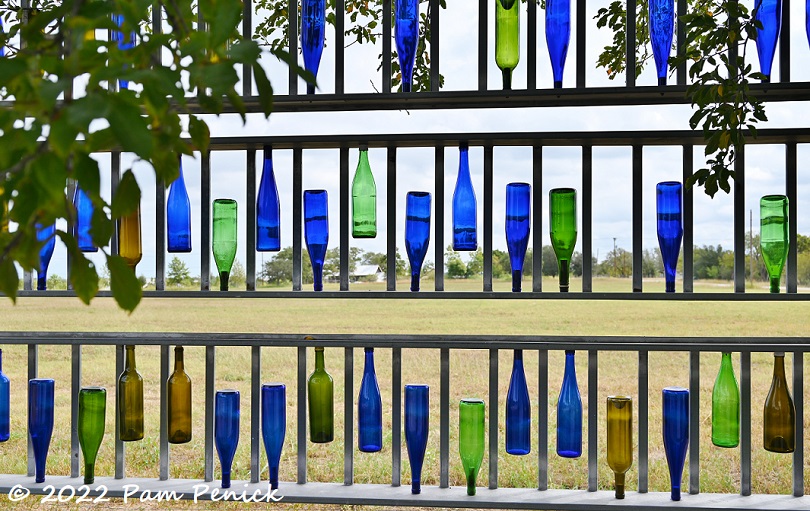
It’s a marvelous effect — playful and artistic.
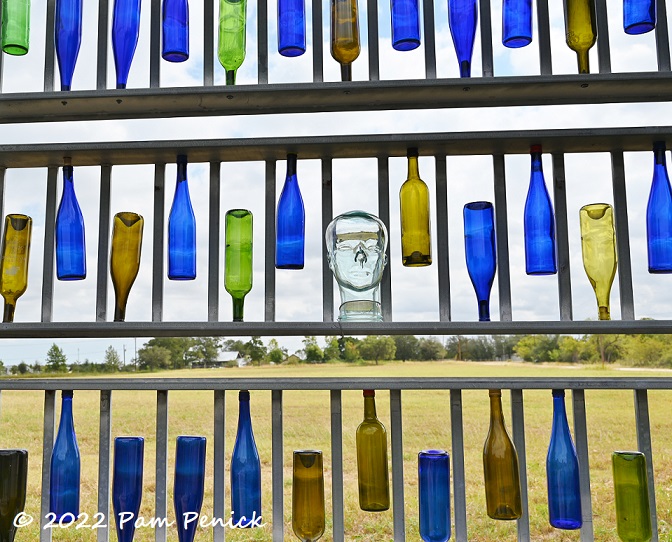
There are even a few glass heads mixed in, watching you.
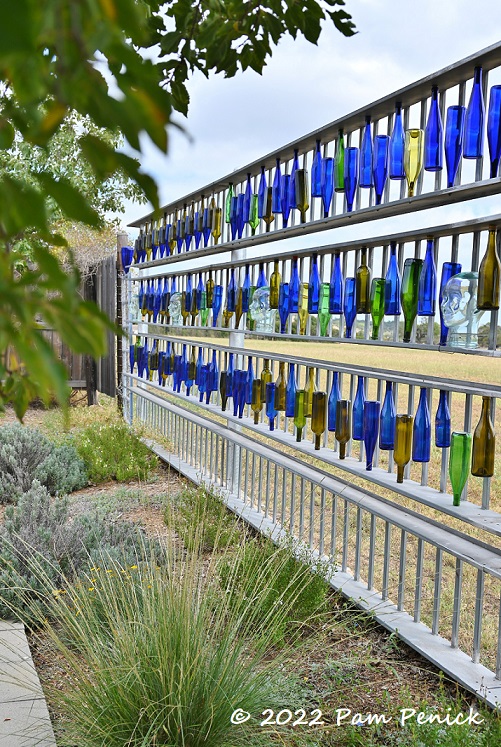
Paula served us lunch after our tour, and we learned that she’s put her beautifully restored farmhouse and Gilbriar Gazebo business up for sale. If you’ve always dreamed of owning property in the Texas Hill Country and running a wedding rental business — with lovely gardens! — this is your chance. Paula is selling the place and 5 acres of the property; here’s the real estate listing.
Paula is holding onto 5 acres at the back, near the lion dens, where she’s planning to build the house she’s been dreaming of since childhood — the dome house. She showed us a 3D-printed model, its futuristic white domes somewhat resembling Luke Skywalker’s childhood home on Tatooine. I’d just read about the actor Robert Downey Jr.’s own dome house in Malibu, and I shared Paula’s enthusiasm for her brave new architectural venture. I’m sure it’ll be fabulous, and I hope to one day see the next evolution of Gilbriar Gardens.
Thanks, Paula, for a lovely tour of your gardens and lunch!
__________________________
Digging Deeper
Come learn about gardening and design at Garden Spark! I organize in-person talks by inspiring designers, landscape architects, authors, and gardeners a few times a year in Austin. These are limited-attendance events that sell out quickly, so join the Garden Spark email list to be notified in advance; simply click this link and ask to be added. Season 8 kicks off in fall 2024. Stay tuned for more info!
All material © 2025 by Pam Penick for Digging. Unauthorized reproduction prohibited.


Pam, thanks so much for linking my old post! As I read your wonderful take on Paula’s place I thought it would be helpful if everyone could see some of the “Before” photos to get a idea of just how much vision and work was involved in her transformation of what was a very derelict property.
So glad you had a chance to visit and enjoy your day at Gilbriar Gazebo.
Her “before” photos, which she showed us, really do bring home how much she’s updated the place. Your post, by the way, was a good reference for me before I arrived. Anyone interested in what Paula has done with this property should definitely check it out.
Thanks, Pam, for the lovely post. You made everything look so good that I almost don’t want to sell it. Nah, just kidding, I’m all about the domes these days. You will have to come back when they are built.
I will look forward to that day, Paula!
Wow, what a lovely space—that just goes on and on! I kept thinking “I feel like I’ve been here before”, thanks for linking to Shirley’s post so I knew I wasn’t loosing my mind!
Yep, Shirley shared it a few years ago, and I’ve been looking forward to a visit ever since.
The concrete pipe planters are awesome, and the bottle fence is the best use of empty bottles I’ve seen.
Yes and yes! 🙂